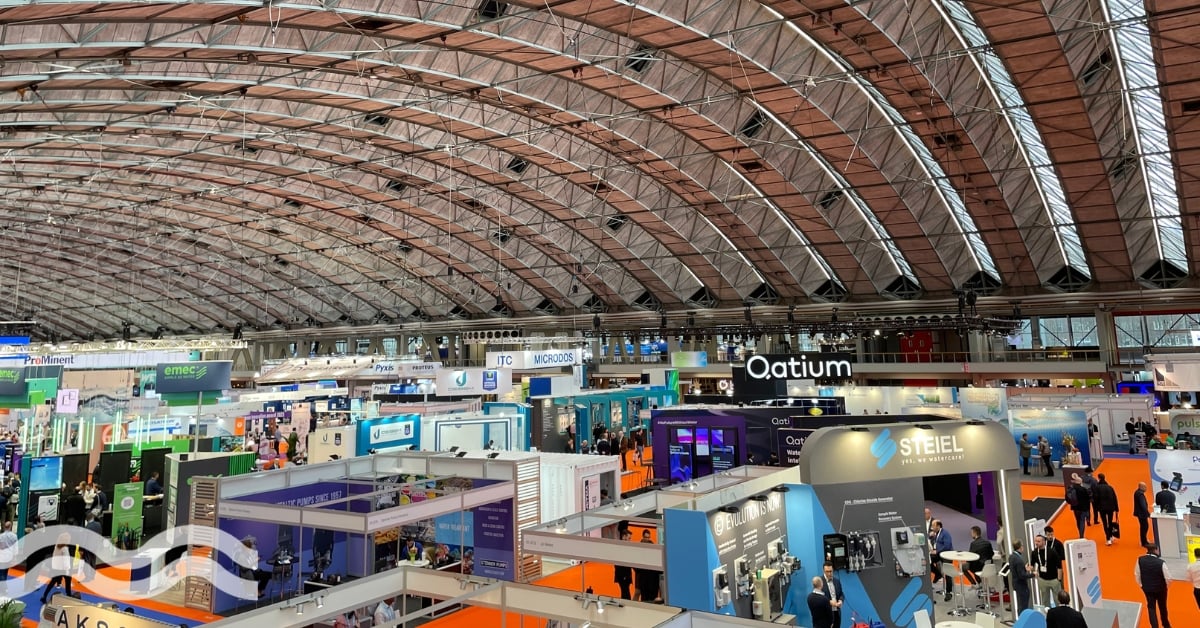NX Filtration makes a splash at Aquatech Amsterdam following IPO

After raising €165 million through an IPO, NX Filtration aims to tackle micropollutants with its hollow fibre nanofiltration membranes. We caught up with CEO Michiel Staatsen at Aquatech Amsterdam to find out more.
Bringing everyone together
Michiel Staatsen is a man in high spirits.
And it’s not surprising. As the CEO of Dutch membrane technology start-up NX Filtration, he has just led the company through an initial public offering (IPO), raising €165 million.
Riding the wave of post-IPO success, the team showcased its “breakthrough technology” – energy and chemical efficient hollow fibre membranes at Aquatech Amsterdam. It used the event as a reunion and first gathering for its growing team.
"We've had people working for us over a year, but we’ve never met in person, so Aquatech Amsterdam was the first chance to bring everyone together,” said CEO Michiel Staatsen enthusiastically.
Staatsen said they received multiple enquiries during Aquatech over water treatment and reuse.
Speaking to Aquatech Online, he said: "Wastewater reuse is one of the most effective ways of reducing the water footprint of a company in water-stressed geographics area. At Aquatech, we had enquiries from both industrial and municipal customers looking at sustainable ways to reduce their water footprints."
A breakthrough product needing capital
NX Filtration was founded by Erik Roesink, professor at the University of Twente, also involved in the development of X-flow’s ultrafiltration (UF) membranes.
The company believes that by providing the performance of nanofiltration, but from an ultrafiltration (UF) like hollow fiber membrane, it can save both capital costs and operational costs with a smaller footprint and offering strong sustainability benefits.
"The whole IPO is geared towards speeding up.”
“The whole IPO is geared towards speeding up,” said the CEO. “We saw we had a unique breakthrough product and we developed production capabilities, we proofed the concept, and we see a huge upcoming market with all the water issues there are in the world. So we want to speed up. To speed up we needed capital, so we raised €165 million.”
For the IPO, NX Filtration sold 30 per cent of the business. Staatsen said the raised capital will be invested into the commercial roll-out of the membranes, growing the international team and significantly building out the production capacity.
“We will continue to bring the pilot projects to customers, to engineering companies and OEMs to get their own experience with the capabilities of the membranes.”
Building a membrane mega factory
The company recently secured land in Hengelo, Netherlands, for a €40 to €45 million high-tech mega factory for nanofiltration membrane production.
"This will be a state the art, mega factory which will provide us with the economies of scale that you need to be competitive and supply the larger projects that we see in the market."
The third pillar of the investment will be R&D, as well as acquiring complementary companies.
“We want to say ahead of the curve and have a lot of ideas and what will come next. That’s an important factor and also on merger & acquisition (M&A) we keep our eyes open to see if we can grow faster in certain markets.”
The pilot model
The company started 2021 with 34 staff, grew to 50 and is expecting to reach over 200 people once the mega factory is fully operational.
NX Filtration’s business model and future revenue are based on converting existing pilot agreements into larger-scale commercial arrangements.
"Pilots are an essential tool for us," says Staatsen. “As we are offering new technology, there needs to be a proof of concept and to do this; you need pilots. This is really important to bring the technology to the market and to bring customers through the technology adoption phase."
“There’s always a project behind it because nobody will pilot just for the fun of piloting.”
To date, the company has over 30 commercial pilot projects based on rental agreements with customers. Pilot-scale is in the range of 1000-2000 litres/hour.
The strategy is to increase the infrastructure and team where the pilot is located. For example, recruiting application engineers, sales managers and account managers in the US, Singapore and other parts of the world.
“There’s always a project behind it because nobody will pilot just for the fun of piloting,” adds the CEO. “That's the commercial roll out model – the pilot maybe 1000-2000 litres/hour, but the commercial follow up projects are much larger."
Micropollutants
Tackling micropollutants and contaminants of emerging concern will be a big play for the company, according to Staatsen.
The CEO added: “This is really important, especially with these upcoming issues such as micropollutants, PFAS, pesticides – threatening our drinking water resources, coupled with climate change and the scarcity issues we face globally.”
“The original development of the membrane was centred around micropollutants, and where we've been practising, the applications that will really excel are both on the drinking water side, as well as on the wastewater side.
“On the drinking water side, we can very effectively make drinking water from surface water and well water. On the wastewater side, we can prevent those chemicals from being discharged into the environment. So those are the fields we're targeting.”


